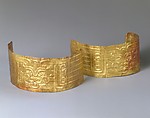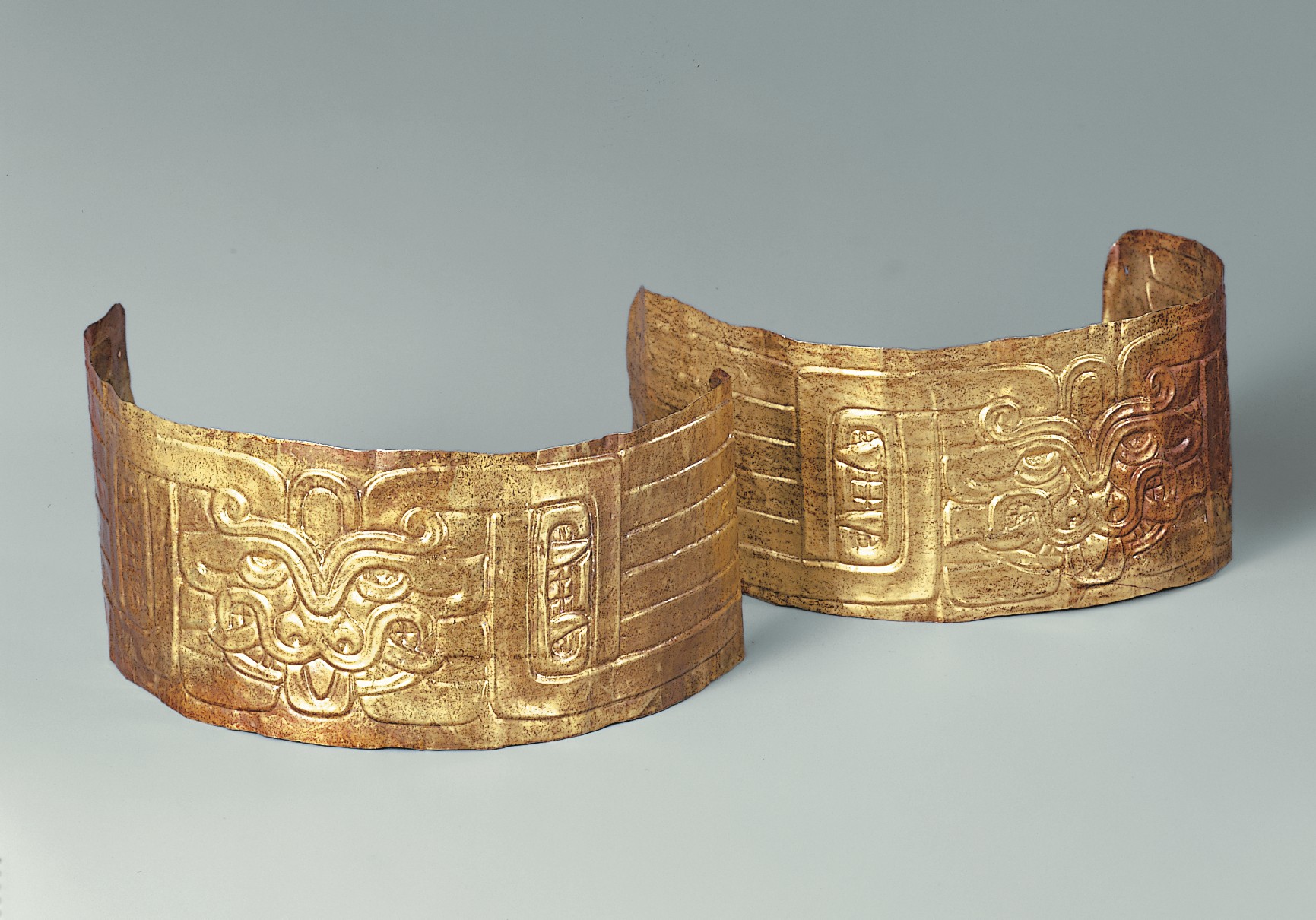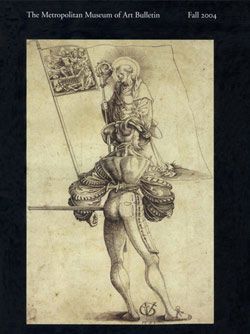Arm bands
Not on view
Beginning in the Formative Period, ancient Andean people used metalwork as a means and medium for communication (Lechtman 1996:35). During this period, the use of gold for crowns, pectorals, and nose ornaments grew exponentially. Nonetheless, arm bands are rarely seen in collections of ancient Peruvian gold. The most significant objects of ornamentation from this period have been found in burials at the site of Kuntur Wasi in the northern highlands (Onuki 1997, 2011). A gold crown excavated from this important ceremonial center features five stylized feline faces (Onuki 1997:86; 2017:17; Boswell 2017:139) that are almost identical to the figures on these unique arm bands.
This pair of matching gold arm bands is embossed with masterfully balanced zoomorphic faces. The most dominant feature of the feline figure is an upward curved and fanged mouth that spreads across the lower half of the composition. Two canine teeth emerge from the corners of the mouth and a central tooth, overlapping a rounded tongue, anchors the central axis. A large nose is situated directly above, with flaring nostrils and a wide bridge that connects the nose to a prominent, V-shaped eyebrow. The eyebrow, which stretches above both eyes, serves a dual purpose – when rotated 180 degrees, the upward peering eyes transform into a downward gaze. From the upside-down perspective the curls at the corner of the feline brow are metamorphized into corners of a subsidiary figure’s mouth.
The secondary face resembles the frontal view of a bird’s beak, pointed in the center and opened widely with an outstretched tongue that mirror’s its feline counterpart. The feline/avian face of the arm bands are framed by matching cartouches filled with incisors and two prominent canines. The points of the teeth direct the eye away from the face and towards the periphery of the composition. The viewer’s eye follows six parallel, banded lines that terminate in repetitive, angled points at the edge of the bands. The stylized lines invoke the sense of feathers on the outstretched wing of an avian figure, complementing the secondary, avian face of the central image. Transformation between avian and feline figures is a defining marker of art from the Peruvian Formative period to which the arm bands date (also see Pectoral 1999.365). These elements are particularly prevalent at Chavín de Huántar, where relief sculpture formed the basis for characterizing the style of this period.
Although the faces of the arm bands are rendered in a frontal perspective, they appear disproportionate in the photograph. When worn, the bands form a circle, creating a shape that served to correct visual inconsistencies and added dimension to an otherwise two-dimensional image. The 2 ¾ inch (7 cm) diameter of the armbands indicates that these were likely worn around the wrists. This idea is further supported by figural images carved in stone relief at Chavín, where human, anthropomorphic, and zoomorphic figures are rendered with bands that demarcate the space between arm and hand. When worn as bracelets, the adorning items were objects in perpetual motion. As the wearer enacted ritual behavior, the pieces oscillate between the two perspectives. Additionally, bilateral symmetry ensured that the adorned individual and his or her bystanders simultaneously experienced the image from opposite perspectives.
Hammered sheet metal objects, such as these, called upon the texture of the repoussé surfaces to convey standardized imagery of a growing regional religious tradition. The visibility of the iconography hinged on a delicate balance between shadow and light. Outdoors in the large plazas of the period’s ceremonial centers, gold adornments reflected the sun’s powerful rays; in interior spaces, diffused light deepened the shadows on the relief surface, allowing the hammered imagery to reveal itself. Ephemeral torch light might have enlivened the faces of the anthropomorphic figures, indicating that gold objects (and their decorated surfaces) were conceived as a powerful medium for communicating innovative religious ideologies.
Patricia A. Lagarde, Andrew W. Mellon Fellow, January 2021
References and further reading
Boswell, Alicia. 2017. “Cat 7. Crown with Five Stylized Feline Faces.” In Golden Kingdoms: Luxury Arts in the Ancient Americas. Edited by Joanne Pillsbury, Timothy Potts, and Kim N. Richter, 138-139. Los Angeles: The J. Paul Getty Museum and The Getty Research Institute.
Lechtman, Heather. 1996. “Cloth and Metal: The Culture of Technology.” In Andean Art at Dumbarton Oaks, vol. 1. Edited by Elizabeth Hill Boone, 33-43. Washington, D.C.: Dumbarton Oaks.
Onuki, Yoshio. 1997 “Ocho tumbas especiales de Kuntur Wasi.” Boletin de Arqueología PUCP 1:79-114.
Onuki, Yoshio. 2008. “La iconografía en los objetos del sitio de Kuntur Wasi.” Boletín de Arqueología PUCP 12:203-18.
Onuki, Yoshio. 2017. “Kuntur Wasi.” In Golden Kingdoms: Luxury Arts in the Ancient Americas. Edited by Joanne Pillsbury, Timothy Potts, and Kim N. Richter, 17. Los Angeles: The J. Paul Getty Museum and The Getty Research Institute.
Onuki, Yoshio, and Kinya Inokuchi. 2011. Gemelos prístinos: El Tesoro del templo de Kuntur Wasi. Lima: Fondo Editorial del Congreso del Perú and Minera Yanacocha.
Due to rights restrictions, this image cannot be enlarged, viewed at full screen, or downloaded.
This artwork is meant to be viewed from right to left. Scroll left to view more.




